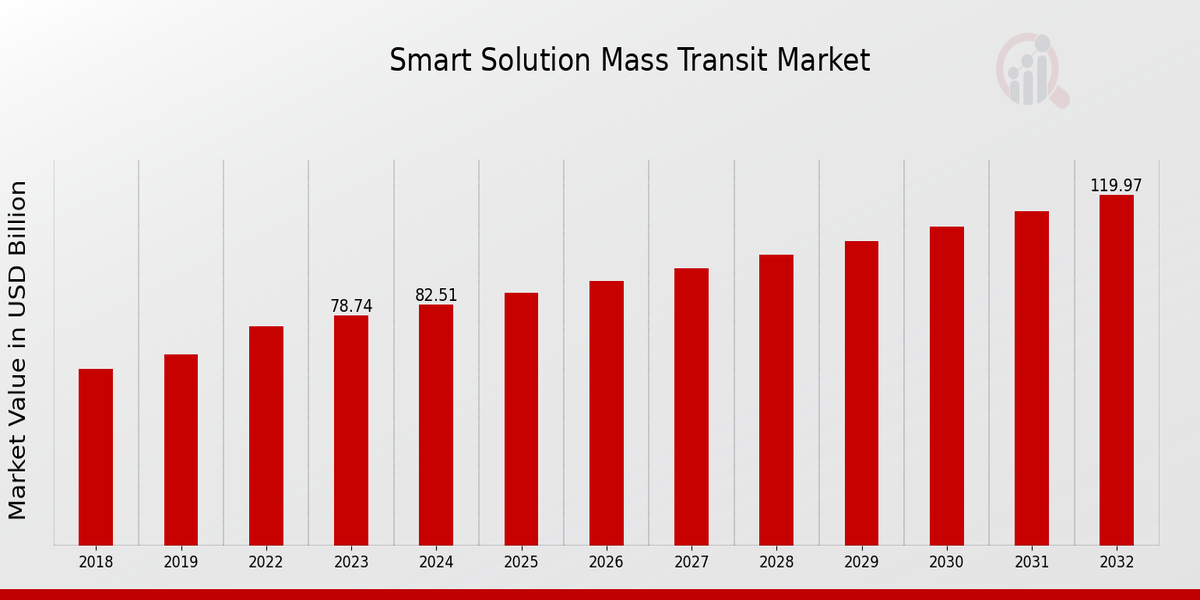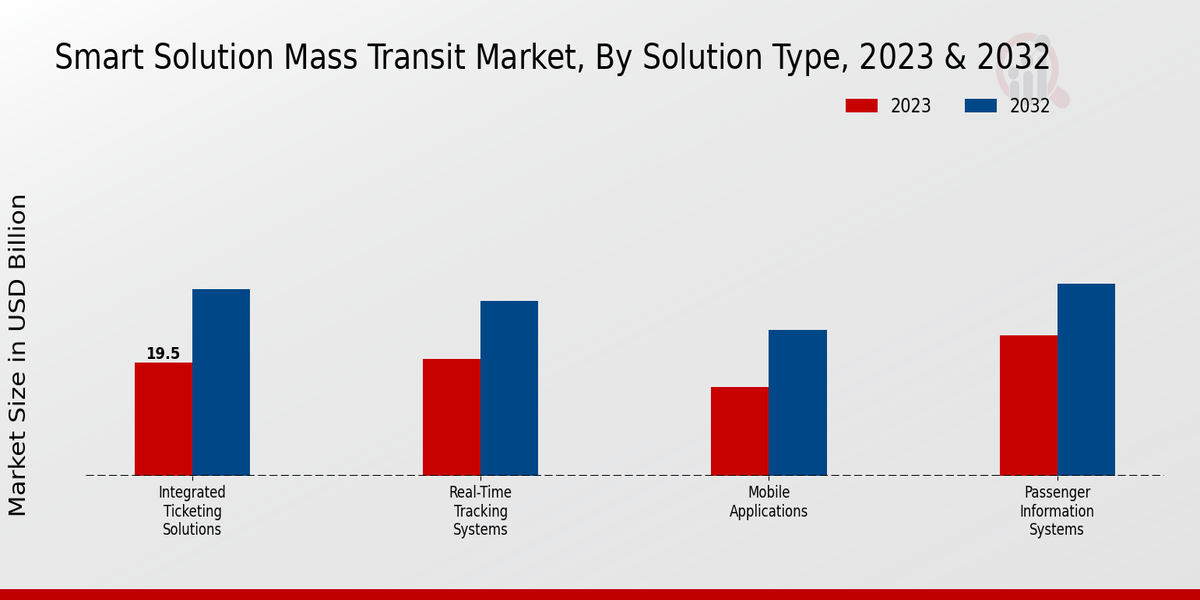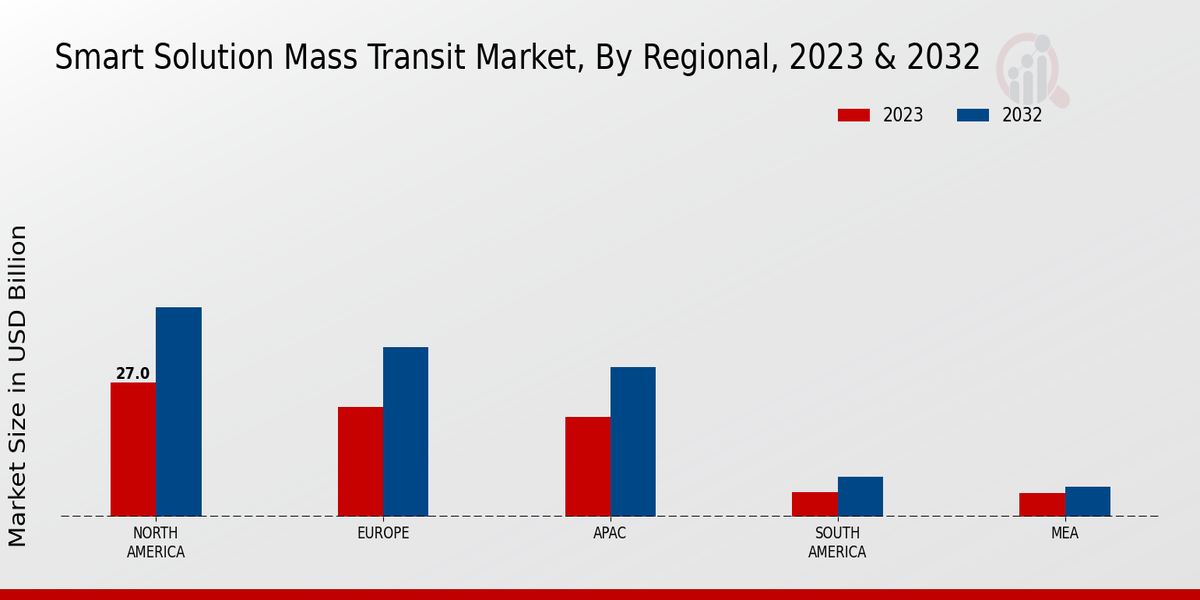Smart Solution Mass Transit Market Overview
As per MRFR analysis, the Smart Solution Mass Transit Market Size was estimated at 75.14 (USD Billion) in 2022. The Smart Solution Mass Transit Market is expected to grow from 78.74 (USD Billion) in 2023 to 120.0 (USD Billion) by 2032. The Smart Solution Mass Transit Market CAGR (growth rate) is expected to be around 4.79% during the forecast period (2024 - 2032).
Key Smart Solution Mass Transit Market Trends Highlighted
The Smart Solution for the World Growing urbanization and the demand for effective transportation networks are driving revolutionary developments in the mass transit market. The adoption of smart transit solutions has been driven by an increasing focus on sustainability and lowering carbon footprints.
Technology advancements including mobile apps, Internet of Things gadgets, and real-time data analytics are improving user experience and operational effectiveness. In response to public demand for more sophisticated transit systems, governments around the world are investing in smart infrastructure.
There are several opportunities to include renewable energy sources, which can offer environmentally suitable substitutes for powering mass transit. Furthermore, the increasing demand for hybrid and electric cars offers an opportunity to update fleets, which will lower emissions and enhance urban air quality. In order to better fulfill the varied demands of commuters, tech businesses and transportation authorities can work together to improve service quality and operational agility.
As the demand for seamless and reliable transit solutions rises, there is potential for innovative partnerships to develop smart ticketing systems, fare collection methods, and mobility-as-a-service platforms that can shape the future of mass transit. Recent trends reflect an increasing focus on passenger safety and comfort, especially in light of global challenges such as health crises.
Enhanced surveillance, contactless payment systems, and improved sanitation measures are now priorities for transit authorities. Public awareness of transit equity is also growing, pushing stakeholders to develop solutions that cater to underserved communities.
This broad perspective on accessibility ensures that smart solutions not only enhance efficiency but also promote social equity in mass transit systems. As the landscape continues to evolve, the potential for advanced smart solutions in mass transit remains promising.

Source: Primary Research, Secondary Research, Market Research Future Database and Analyst Review
Smart Solution Mass Transit Market Drivers
Increased Urbanization and Population Growth
The ongoing trend of urbanization significantly fuels the growth of the Global Smart Solution Mass Transit Market. As more people migrate to urban areas in search of better employment opportunities and improved living standards, cities are faced with the challenge of accommodating increasing populations.
This surge in urban population drives the need for robust and efficient mass transit solutions. Smart technologies play a crucial role in addressing the complexities of urban transit systems by enhancing their efficiency and accessibility.
With a rising number of commuters, there is an escalating demand for innovative transit solutions that make use of data analytics, mobile applications, and intelligent transport systems to streamline schedules and routes. These technologies can reduce congestion, improve safety, and offer a better overall user experience.
By implementing smart solutions, transit authorities can optimize resource allocation, using analytics to fine-tune operations and extend service networks to underserved regions.
Furthermore, these advancements contribute to a reduction in the environmental impact of mass transit systems, making them more sustainable and appealing to local governments and citizens alike, thereby reinforcing growth in the Smart Solution Mass Transit Market.
Government Initiatives and Funding
Government initiatives aimed at improving public transportation infrastructure play a critical role in driving growth within the Global Smart Solution Mass Transit Market. Many governments recognize the importance of investing in advanced mass transit solutions to reduce traffic congestion, enhance public safety, and lower greenhouse gas emissions.
Increased funding for smart mass transit projects is encouraging the adoption of modern technologies such as contactless payment systems, real-time tracking applications, and automated vehicles. These initiatives not only promote the development of smarter solutions but also encourage partnerships between public and private sectors, thereby speeding up the implementation of innovative transit solutions.
Technological Advancements
Rapid advancements in technology serve as a key driver for the Global Smart Solution Mass Transit Market. The integration of technologies such as artificial intelligence, the Internet of Things (IoT), and big data analytics into mass transit systems enhances operational efficiency and improves the overall passenger experience.
These technologies allow for real-time monitoring and data analysis, leading to informed decision-making and better resource management. As transit organizations adopt smart technologies, they can provide more reliable services, reduce operational costs, and increase customer satisfaction, driving the growth of the mass transit market further.
Smart Solution Mass Transit Market Segment Insights
Smart Solution Mass Transit Market Solution Type Insights
The Smart Solution Mass Transit Market witnessed substantial growth, particularly within the Solution Type segment, which includes Integrated Ticketing Solutions, Real-Time Tracking Systems, Mobile Applications, and Passenger Information Systems.
In 2023, the Integrated Ticketing Solutions segment was valued at 19.5 USD Billion, reflecting its critical role in improving passenger convenience and streamlining fare collection processes in mass transit systems. This segment's growth is attributed to rising urbanization and demand for contactless payment options, paving the way for enhanced operational efficiency and passenger satisfaction.
In contrast, the Real-Time Tracking Systems segment held a market value of 20.0 USD Billion, dominating the landscape with innovative technologies that provided accurate updates to passengers regarding vehicle locations and schedules. This capability was essential for improving the user experience and ensuring timely connections, as it significantly reduced waiting times and enhanced overall service reliability.
Meanwhile, Mobile Applications were valued at 15.2 USD Billion, largely attributed to the increasing reliance on smartphones for accessing real-time transit information and enabling seamless trip planning. By integrating various transit services into user-friendly applications, mass transit authorities can drive user engagement and improve ridership rates.
The Passenger Information Systems segment, valued at 24.04 USD Billion, played an essential role by providing passengers with timely updates and essential travel information, facilitating better travel decisions and a more informed commuting experience. The importance of this segment lies in its ability to connect disparate information and ensure passengers receive up-to-date details.
The collective growth in these segments contributed to the overall advancement of the Smart Solution Mass Transit Market, addressing the diverse needs of urban transit systems while also enhancing passenger experience through technology.
As cities continue to expand, the need for more comprehensive and integrated solutions is predicted to drive innovation and market growth. Each segment not only plays a distinctive role but also significantly influences the efficiency and effectiveness of mass transit systems, making them indispensable in the evolution of urban mobility.
As the market continues to evolve, stakeholders must focus on leveraging technology to maximize the benefits of these solutions, thus adapting to the changing landscape of urban transportation. Ultimately, the steady growth and importance of these various segments demonstrate the ongoing transition towards smarter and more efficient public transport worldwide.

Source: Primary Research, Secondary Research, Market Research Future Database and Analyst Review
Smart Solution Mass Transit Market End Use Insights
The Smart Solution Mass Transit Market showcases a robust landscape characterized by diverse end-use categories that play a crucial role in shaping market dynamics. Within this market segmentation, Public Transport Operators stand out as a major contributor, leveraging smart solutions to enhance operational efficiency and improve passenger experience.
Meanwhile, Private Transport Services are gaining significant traction, promoting convenience and flexibility through the integration of technology. Government Agencies also play a pivotal role in driving the adoption of smart transit solutions to promote sustainability and reduce congestion in urban areas.
The interplay of these end-use sectors not only reflects the growing demand for smarter transit systems but also highlights opportunities for innovation and development within the Global Smart Solution Mass Transit Market. With ongoing trends in urbanization and technological advancement, an increase in public-private partnerships is anticipated, further driving market growth and shaping the future of intelligent mass transit systems.
Smart Solution Mass Transit Market Technology Insights
The Smart Solution Mass Transit Market is experiencing growth driven by advancements in technology. This market segment encompasses various innovative solutions that enhance operational efficiency and user experience in mass transit systems.
IoT Solutions play a crucial role, enabling real-time data collection and monitoring, which facilitates improved service delivery. Artificial Intelligence significantly impacts decision-making processes, optimizing routes and schedules based on dynamic data inputs.
Big Data Analytics is vital for processing large volumes of transit data, helping organizations derive actionable insights and improve overall service. Cloud Computing serves as the backbone of these technologies, providing scalable infrastructure for data storage and access. The pressing need for sustainable and effective transportation solutions continues to drive investment and innovation in this sector, presenting ample opportunities for stakeholders involved.
Smart Solution Mass Transit Market Application Insights
The Smart Solution Mass Transit Market showcases a diverse Application landscape, incorporating various transportation modes like Bus Transit, Rail Transit, Metro Systems, and Tram Systems. This segmentation highlights the market's adaptability to urban mobility needs, with each mode catering to different commuter preferences and requirements.
Bus Transit represents a significant portion of this market, offering flexibility and accessibility, particularly in densely populated areas. Rail Transit plays a crucial role in long-distance travel, enhancing connectivity between regions, while Metro Systems cater specifically to urban environments, facilitating efficient transit for city dwellers.
Tram Systems, though often underrepresented, contribute to sustainable urban transport solutions, seamlessly integrating into city infrastructure. As cities continue to expand, the demand for innovative smart solutions across these applications is expected to grow, driven by the need for efficient, reliable, and eco-friendly public transport options.
The ongoing transformation in urban mobility, characterized by technological advancements and increased investments, sets the stage for robust market growth within the Global Smart Solution Mass Transit Market.
Smart Solution Mass Transit Market Regional Insights
The Smart Solution Mass Transit Market saw significant growth across various regions, with North America leading the market, holding a valuation of 27.0 USD Billion in 2023 and expected to rise to 42.0 USD Billion by 2032, showcasing its dominant position due to advanced technology integration and infrastructure.
Europe followed closely with a market value of 22.0 USD Billion in 2023, anticipated to reach 34.0 USD Billion by 2032, driven by a strong focus on sustainable and efficient transit systems. The APAC region, featuring a valuation of 20.0 USD Billion in 2023, rising to 30.0 USD Billion, represented a significant growth opportunity due to urbanization and increased investments in public transport.
South America, while smaller with values of 5.0 USD Billion in 2023 and 8.0 USD Billion in 2032, was gradually evolving with urban development needs. Lastly, the Middle East and Africa, starting with a valuation of 4.74 USD Billion in 2023 and moving to 6.0 USD Billion, faced unique challenges but are actively seeking innovative solutions for transit efficiency.
This insight into the Smart Solution Mass Transit Market segmentation highlighted varying growth drivers and emphasized the significance of regional investments and infrastructure development.

Source: Primary Research, Secondary Research, Market Research Future Database and Analyst Review
Smart Solution Mass Transit Market Key Players and Competitive Insights:
The Smart Solution Mass Transit Market is experiencing considerable evolution driven by rapid technological advancements aimed at enhancing urban mobility and passenger experience. This market encompasses a range of innovative solutions designed to streamline public transport systems, improve operational efficiency, and provide real-time information to users.
Competitive insights in this market reveal a landscape characterized by significant investments in smart technology, partnerships between public and private sectors, and a strong focus on sustainable transport solutions. Key players are adopting various strategies, including mergers and acquisitions, collaborations, and innovation in product offerings to capture a larger share of this growing market.
As urbanization increases and the demand for efficient public transport rises, understanding the competitive dynamics within this market becomes crucial for stakeholders aiming to establish and maintain a market presence. Cisco Systems plays a pivotal role in the Smart Solution Mass Transit Market by leveraging its advanced networking capabilities and Internet of Things (IoT) technology to deliver integrated solutions that address the challenges faced by mass transit systems. The company is renowned for its strong emphasis on cybersecurity, which is critical in ensuring the safety and reliability of transit solutions.
Cisco's robust infrastructure facilitates real-time data analytics and communications among transit authorities, enabling optimized operations and improved service delivery. With its global reach and expertise in network management, Cisco Systems enhances the passenger experience through connected transport systems, thereby solidifying its position as a leading innovator in the industry.
INIT, a prominent player in the Smart Solution Mass Transit Market, is recognized for its comprehensive suite of intelligent transport solutions tailored to meet the demands of urban mobility. The company excels in offering integrated software solutions for fare management, vehicle location, and passenger information systems, which aid transit authorities in enhancing operational efficiency.
INIT's dedicated focus on providing customizable solutions allows it to meet the unique needs of various transit systems worldwide, fostering innovation and adaptability in a competitive environment. Their commitment to sustainable transport development and constant technological improvement enables INIT to serve as a vital contributor to the transformation of public transportation systems, ultimately enriching the overall passenger experience.
Key Companies in the Smart Solution Mass Transit Market Include:
Smart Solution Mass Transit Market Developments
Recent developments in the Smart Solution Mass Transit Market indicate significant growth and technological advancements among key players. Cisco Systems has been enhancing its infrastructure offerings to support smart transit solutions, while INIT is expanding its software solutions for improved network management.
Hitachi is solidifying its presence through collaborations aimed at integrating advanced IT systems within public transport networks. Companies like IBM and Alstom are focusing on AI and IoT solutions to provide enhanced passenger experiences and optimize operations.
Furthermore, key acquisitions are shaping the market dynamics; noteworthy mergers include Cubic Corporation's acquisition of traffic technology firms to bolster its service portfolio, and Thales has been increasing its stake in mobility services through strategic partnerships.
The growing need for efficient and reliable mass transit solutions is reflected in the rising market valuation, with organizations investing heavily in innovative technologies to improve connectivity and overall efficiency in urban transport systems. The increasing adoption of smart ticketing and real-time tracking technologies contributes to a more integrated transit experience poised to benefit both providers and users in the near future.
Smart Solution Mass Transit Market Segmentation Insights
Smart Solution Mass Transit Market Solution Type Outlook
- Integrated Ticketing Solutions
- Real-Time Tracking Systems
- Passenger Information Systems
Smart Solution Mass Transit Market End Use Outlook
- Public Transport Operators
- Private Transport Services
Smart Solution Mass Transit Market Technology Outlook
Smart Solution Mass Transit Market Application Outlook
Smart Solution Mass Transit Market Regional Outlook
| Report Attribute/Metric |
Details |
| Market Size 2022 |
75.14 (USD Billion) |
| Market Size 2023 |
78.74 (USD Billion) |
| Market Size 2032 |
120.0 (USD Billion) |
| Compound Annual Growth Rate (CAGR) |
4.79% (2024 - 2032) |
| Report Coverage |
Revenue Forecast, Competitive Landscape, Growth Factors, and Trends |
| Base Year |
2023 |
| Market Forecast Period |
2024 - 2032 |
| Historical Data |
2019 - 2023 |
| Market Forecast Units |
USD Billion |
| Key Companies Profiled |
Cisco Systems, INIT, Hitachi, Genfare, Kapsch TrafficCom, Alstom, IBM, Techniq, Ridango, MobiRail, Thales, Siemens, Bombardier, Cubic Corporation, Trapeze Group |
| Segments Covered |
Solution Type, End Use, Technology, Application, Regional |
| Key Market Opportunities |
Integration of AI technologies, Expansion of electric vehicles, Real-time data analytics, Smart ticketing solutions, Sustainability-focused initiatives |
| Key Market Dynamics |
Technological advancements in transportation, Increasing urbanization and population, Demand for eco-friendly solutions, Government investments in infrastructure, Need for improved passenger experience |
| Countries Covered |
North America, Europe, APAC, South America, MEA |
Frequently Asked Questions (FAQ):
The Smart Solution Mass Transit Market is expected to be valued at 120.0 USD Billion by 2032.
The expected CAGR for the Smart Solution Mass Transit Market from 2024 to 2032 is 4.79%.
North America is expected to hold the largest market share in the Smart Solution Mass Transit Market, valued at 42.0 USD Billion by 2032.
The Integrated Ticketing Solutions segment is expected to be valued at 32.0 USD Billion by 2032.
By 2032, the market size for Real-Time Tracking Systems is anticipated to reach 30.0 USD Billion.
The projected market value of Passenger Information Systems is expected to be 33.0 USD Billion by 2032.
Major players expected to lead the market include Cisco Systems, INIT, Hitachi, Genfare, and Kapsch TrafficCom.
The market value for Mobile Applications is anticipated to be 25.0 USD Billion by 2032.
The expected market size for the APAC region is projected to be 30.0 USD Billion by 2032.
In 2023, the South American market was valued at 5.0 USD Billion.

















